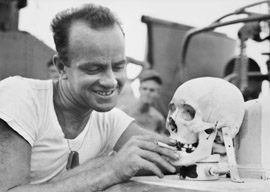
April 08, 2011

The US has another public-relations nightmare on its hands in Afghanistan. One would think a war lasting over a decade with no plausible end in sight would be enough of a PR disaster.
This month’s issue of Rolling Stone magazine published numerous photos of American soldiers posed with and in the act of mutilating dead bodies. This followed a similar expose in Der Spiegel a week prior.
In addition to the photographs are firsthand accounts of stomach-churning depravity. Not least of the sickening details are that the targets were both quite young and possibly quite innocent.
Though I am as disgusted by these things as the next person, I am not at all surprised.
I am old enough to know that this was to be entirely expected. Once upon a time, when men were men, women were women, courtesy was courtesy, decorum was decorum, intelligence was intelligence, success was success, failure was failure, and war was war, people knew what to expect from each. Today all those definitions have been jumbled. We are shocked”shocked, I tell you”by the results.
Especially in the case of armed conflict. Sadly, these are precisely the things one should anticipate in wartime.
They have happened before. Many think that such acts didn”t happen because they aren”t shown in the classic propaganda films every month on TCM. Think again.
During World War II (and World War I, and probably as long as there have been wars), soldiers have taken war trophies. Much more often than one would like to think, these have been in the form of body parts.
“It’s long past time people remembered what the word “war” really means.”
For any disbelievers, here is a little ditty from the poet Winfield Townley Scott. It’s called “The US Sailor with the Japanese Skull” and relates the technique for preserving such souvenirs.
Lest one think this was an isolated practice, Edward L. Jones, a war correspondent for Atlantic Magazine in the Pacific, wrote in February 1946: “We boiled the flesh off enemy skulls to make table ornaments for sweethearts, or carved their bones into letter-openers.”
For more personal convincing, look in the local newspaper for the estate auction of any man who served as a soldier in the Far East during the 1930-1945 period of conflict. If you attend half a dozen of them I assure you that you will find a human skull among the detritus of a life lived through war.
One need not confine himself to seeking skulls. Any number of desktop artifacts or general curiosities were made from enemy soldiers” body parts. President Roosevelt himself was reportedly given a letter-opener made from a Japanese soldier’s arm bone. (To his credit, it was said that he asked it be given a proper burial.) Gold teeth were another popular item to bring home.
Similar monstrosities were perpetrated on a monumental scale, even by the so-called “Greatest Generation.” These are given short shrift or ignored by most elegiacs.